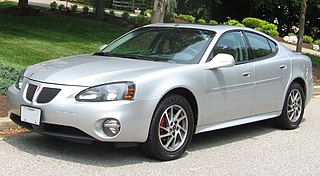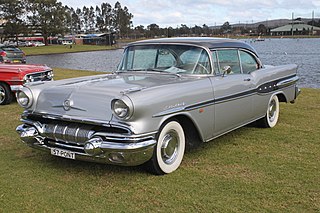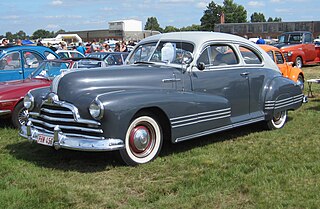Related Research Articles

The Country Music Hall of Fame and Museum in Nashville, Tennessee, is one of the world's largest museums and research centers dedicated to the preservation and interpretation of American vernacular music. Chartered in 1964, the museum has amassed one of the world's most extensive musical collections.

Pontiac, or formally the Pontiac Motor Division of General Motors, was an American automobile brand owned, manufactured, and commercialized by General Motors. It was originally introduced as a companion make for GM's more expensive line of Oakland automobiles. Pontiac quickly overtook Oakland in popularity and supplanted its parent entirely by 1933, in turn establishing its position as one of GM's dominant divisions.

The Cadillac Eldorado is a luxury car manufactured and marketed by Cadillac from 1952 until 2002 over twelve generations.

The Grand Prix is a line of automobiles produced by the Pontiac Division of General Motors from 1962 until 2002 as coupes and from 1989 through 2008 model years as four-door sedans.

The Oldsmobile 98 is the full-size flagship model of Oldsmobile that was produced from 1940 until 1942, and then from 1946 to 1996. The name – reflecting a "Series 90" fitted with an 8-cylinder engine – first appeared in 1941 and was used again after American consumer automobile production resumed post-World War II. It was, as it would remain, the division's top-of-the-line model, with lesser Oldsmobiles having lower numbers such as the A-body 66 and 68, and the B-body 76 and 78. The Series 60 was retired in 1949, the same year the Oldsmobile 78 was replaced by the 88. The Oldsmobile 76 was retired after 1950. This left the two remaining number-names to carry on into the 1990s as the bread and butter of the full-size Oldsmobile lineup until the Eighty Eight-based Regency replaced the 98 in 1997.

The Pontiac Catalina is a full-size, junior series automobile produced by Pontiac from 1950 to 1981. Initially, the name was a trim line on hardtop body styles, first appearing in the 1950 Chieftain Eight and DeLuxe Eight lines. In 1959, it became a separate model as the "entry-level" full-size Pontiac.

The Pontiac Bonneville is a model line of full-size or mid-size front-engine rear drive cars manufactured and marketed by Pontiac from 1957 until 2005, with a hiatus for model years 1982-1986.

The Chrysler Imperial, introduced in 1926, was Chrysler's top-of-the-line vehicle for much of its history. Models were produced with the Chrysler name until 1954, after which it became a standalone brand; and again from 1990 to 1993. The company positioned the cars as a prestige marque to rival Cadillac, Continental, Lincoln, Duesenberg, Pierce Arrow, Cord, and Packard. According to Antique Automobile, "The adjective 'imperial' according to Webster's Dictionary means sovereign, supreme, superior or of unusual size or excellence. The word imperial thus justly befits Chrysler's highest priced model."

The Oldsmobile Series 70 is a full-size midrange automobile produced by Oldsmobile between the 1939 and 1950 model years. Oldsmobiles of this time period were in an unusual "middle" position in GM's hierarchy of automobile brands. Chevrolet and Pontiac were the budget priced models, while Buick and Cadillac were the luxury brands. GM would share their "A" body platforms between Chevrolet, Pontiac, and "B" body on Oldsmobile and Buick, while leaving Cadillac on the senior "C" platform. Oldsmobiles were then branded as "luxury level" Chevrolet's and Pontiac's, while Oldsmobiles using the "B" platform were "budget priced" Buicks and Cadillacs.

The Buick Roadmaster is an automobile built by Buick from 1936 until 1942, from 1946 until 1958, and then again from 1991 until 1996. Roadmasters produced between 1936 and 1958 were built on Buick's longest non-limousine wheelbase and shared their basic structure with the entry-level Cadillac Series 65, the Buick Limited, and after 1940, the Oldsmobile 98. Between 1946 and 1957, the Roadmaster served as Buick's flagship.

The General Motors Motorama was an auto show staged by GM from 1949 to 1961. These automobile extravaganzas were designed to whet public appetite and boost automobile sales with displays of fancy concept cars and other special or halo models. Motorama grew out of Alfred P. Sloan's yearly industrial luncheons at New York City's Waldorf-Astoria Hotel, beginning in 1931. They were almost invariably held in conjunction with the New York Auto Show, that for many years was held traditionally in the first week of January.

The Pontiac Parisienne is a full-size rear-wheel drive vehicle that was sold by Pontiac on the GM B platform in Canada from 1958 to 1986 and in the United States from 1983 to 1986. Right-hand drive models were locally assembled in Australia, New Zealand, and South Africa until 1969. For most of its run, the Canadian Parisienne was nearly mechanically identical to the American Chevrolet Impala or Chevrolet Caprice. The Parisienne wagon continued under the Safari nameplate until 1989. Parisienne or La Parisienne means a grammatically female person or thing from Paris, France.

Viking was a brand of automobiles manufactured by General Motors as a supplement to Oldsmobile division for model years 1929 to 1931 and used the GM B platform. It was shared with the Oakland Model 301 for 1930 and 1931.

The Pontiac Star Chief is an automobile model which was manufactured by Pontiac between 1954 and 1966. It was Pontiac's top trim package on the Pontiac Chieftain, with later generations built on longer wheelbases, and serving as the foundation platform for the Pontiac Bonneville. The car was easily identified by its chrome star trim along its sides, a feature all Star Chiefs were equipped with.

Nuta Kotlyarenko, known professionally as Nudie Cohn, was a Ukrainian-American tailor who designed decorative rhinestone-covered suits, known popularly as "Nudie Suits", and other elaborate outfits for some of the most famous celebrities of his era. He also became famous for his outrageous customized automobiles.

Manuel Arturo José Cuevas Martínez Sr. is a Mexican fashion designer best known for the garments he created for prominent rock and roll and country music acts.

A brougham was originally a car body style where the driver sat outside and passengers seated within an enclosed cabin, — deriving the configuration from the earlier brougham horse-drawn carriage. Similar in style to the later town car, the brougham style was used on chauffeur-driven petrol and electric cars.

The Pontiac Streamliner is a full-size car produced under the Pontiac brand by General Motors from 1932 until 1952. A mass-produced and popular vehicle, it was a significant luxury car during the recovery from the Great Depression, and during and immediately after the Second World War.

Valley Relics Museum is a museum located in the San Fernando Valley of Los Angeles. The LA Weekly named the Valley Relics Museum one of its 2017 winners of "Best Of L.A.: Arts & Entertainment".
The Roy Rogers-Dale Evans Museum was a museum in Branson, Missouri, focused on the careers of Roy Rogers and Dale Evans, stars of radio, film and television. The museum was open from 1967 until 2009, at three locations in California and Missouri.
References
- 1 2 3 Bruguiere, Tony (17 January 2011). "Denver businessman displays priceless car belonging to Roy Rogers at NWSS". The Fence Post. Retrieved 20 April 2024.
- ↑ Singer, Drew (7 July 2015). "Did You Know? The Guy Behind Elvis' Rhinestone Suit Also Made Outrageous Cars". gmauthority.com. Retrieved 20 April 2024.
- 1 2 Umberger, Leslie; Doss, Erika (2007). Sublime Spaces and Visionary Worlds - Built Environments of Vernacular Artists. Princeton Architectural Press. p. 231. ISBN 9781568987286.
- 1 2 "History of Nudie Cohn and his Nudie Suits". The Carriage and Western Art Museum. Retrieved 26 March 2024.
- 1 2 3 4 Valdes-Dapena, Peter (21 October 2015). "Driving Nudie Cohn's dazzling Cadillac". CNN. Retrieved 25 March 2024.
- ↑ Nudie, Jamie Lee; Cabrall, Mary Lynn (2004). "Chapter 4: The Cars". Nudie: the Rodeo tailor. Smith, Gibbs Publisher. pp. 62–71. ISBN 978-1-58685-381-5 . Retrieved 26 August 2010.
- ↑ "Nudie's Online Car Museum - page 1". nudiesrodeotailor.com. 2004. Archived from the original on 19 August 2010. Retrieved 25 March 2024.
- ↑ "Nudie's Online Car Museum - page 2". nudiesrodeotailor.com. 2004. Archived from the original on 1 February 2014. Retrieved 25 March 2024.
- ↑ "Webb Pierce and his Nudie cars". mysteryhillbillies.com/. 9 June 2017. Retrieved 25 March 2024.
- ↑ "Webb Pierce's 1962 Pontiac Bonneville - Would you drive it?". steemit.com. 23 August 2018. Retrieved 25 March 2024.
- 1 2 3 "1963 Pontiac Bonneville "Roy Rogers" Nudie Mobile". rmsothebys.com. 2015. Retrieved 25 March 2024.
- ↑ George-Warren, Holly; Freedman, Michelle (2001). How the West was worn . Harry N. Abrams. p. 159. ISBN 978-0-8109-0615-0.
- ↑ Dixon, Chris (4 September 2005). "A Rhinestone Cowboy Who Grabbed Cars by the Horns". The New York Times. Retrieved 26 March 2024.